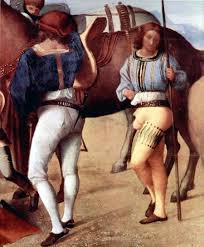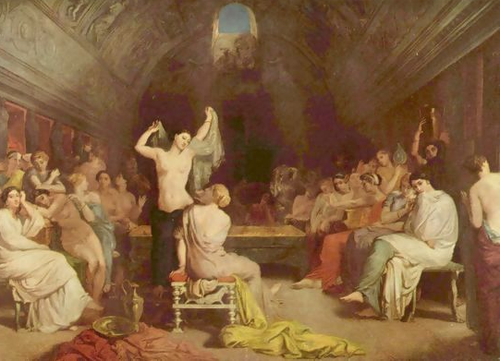History has received a fairly sexy makeover thanks to television shows like Game of Thrones, Spartacus and The Vikings. History, particularly ancient history, has always been something of a box office draw as well with films like Robin Hood, Kingdom of Heaven and even the cult classic Army of Darkness playing on our love of the Middle Ages to bring audiences in.  Our views of various points in history are often shaped by historical fiction, but when it comes to sex during the middle ages, truth proves to me much stranger than fiction.
Our views of various points in history are often shaped by historical fiction, but when it comes to sex during the middle ages, truth proves to me much stranger than fiction.
Courtly Love
Most people are already familiar with the strict rules about not showing public signs of affection, even when a couple was courting. The courting process was designed not so couples could see if they were compatible so much as to determine whether the families would agree to the union. The idea of Courtly Love was born out of this practice. Courtly Love is intense, all-consuming and typically fully unfulfilled. Songs and poems from the period describe Courtly Love as when a knight falls in love with either a young virgin or a married woman, thereby making his love pure but ultimately doomed. Nevertheless, his love for the fair maiden (whomever she may be) gives him the courage and strength to go to war and ultimately sacrifice his life.
The mechanics of S-E-X
Even for couples that ultimately make it to the altar, sex still isn’t a straight-forward proposition. Celibacy was the moral ideal both for single and married people. Although sex was condoned as a part of marriage, it wasn’t something most couples engaged in with vigor and women were taught from a young age that sexual intercourse was something to simply be endured. To be fair, however, the Church’s involvement in acceptable sexual positions probably went a long way to keeping people’s sexual desires at bay. Officially, the only acceptable position was missionary as it was thought to be most likely to produce pregnancy. Still, there were some progressive minds at work at the time. One man, Albertus Magnus, created a list of sexual positions ranked from the acceptable to the obscene. He agreed that the missionary position was still the most acceptable but the remaining four positions indicated varying levels of depravity. The ranking in full was:
- Missionary
- Side-by-side
- Sitting
- Standing
- A Tergo (aka From Behind)
Keep It In the Closet
With the Church being so involved in the daily lives of the citizenry, it should come as no surprise that homosexuality was expressly forbidden. Sexual sinners might have the opportunity to repent but more often than not they were simply punished or tortured to death. But, as with any historical era, there’s plenty of evidence to suggest that a sizeable part of the population was in the closet. King Richard I< better known as Richard the Lionheart, reportedly had a long term affair with King Phillip II while Richard’s wife was getting busy with her own brother.
Matters of Size
Men may think that concerns over penis size is a modern invention but even back in the Middle Ages, men were very conscious of their penis size. Codpieces were developed as a way for men to accentuate and often exaggerate the size of their penis. The Codpiece was a small pouch which was worn outside of a man’s clothes and over his genitals. The pouch was stuffed with cloth, sawdust or anything else until it resembled the shape of the man’s Crown Jewels. If wearing a Codpiece wasn’t a good enough way for men to advertise their natural gifts, they could also choose to wear a special kind of shoe called a poulaine. These long shoes ended in a pointed toe and the belief was that the longer the shoe, the larger the penis – a fashion trend that served to start the idea that a man’s foot size is related to his penis size.
The World’s Oldest Profession
 Church mandates notwithstanding, prostitution was a thriving business in the Middle Ages. Most villages had at least one brother and, in some cases, the local Church condoned prostitution as a way to keep both adultery and homosexuality in check. While officially condemned, prostitutes and the brothels they ran were a large fixture in villages and towns and provided much of the local business and, in some cases, it was seen as an honest profession by the public.
Church mandates notwithstanding, prostitution was a thriving business in the Middle Ages. Most villages had at least one brother and, in some cases, the local Church condoned prostitution as a way to keep both adultery and homosexuality in check. While officially condemned, prostitutes and the brothels they ran were a large fixture in villages and towns and provided much of the local business and, in some cases, it was seen as an honest profession by the public.










